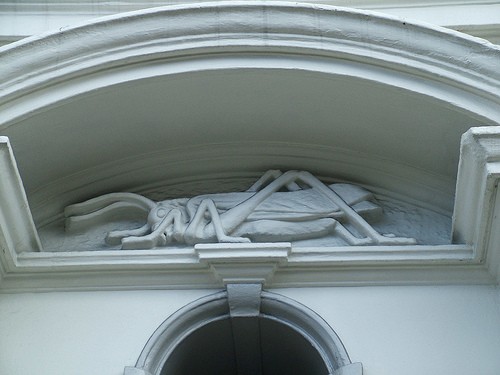
14 October 2015
Martins Bank Logo Image by kenjonbro Above the entrance to Barclays Bank, Lowfield Street, Dartford, Kent.
The name Martin \m(a)-rtin, mar- tin\ is pronounced MART-en. It is of Latin origin, and its meaning is dedicated to Mars. Plague translates as Strike.
In the same manner as Barclays, Martins Bank developed from a London goldsmith’s business; with the first Martin partner being Thomas in 1703 with its customers coming from the commercial rather than personal arena. Despite a serious run on its reserves in 1890 during the Baring crisis Martins survived and became a limited company in 1891. It began to expand as a clearing bank with a few branches, but its main development came after 1918 when it merged with the Bank of Liverpool which was founded in 1831 as one of the first English joint-stock banks, well they had to do something with all that money from the East India Company and its Puritan addiction cultivation and slavery. From this point the banks expansion would be a speedy affair.
By 1926 there were 378 branches, but only 28 were in London and the South with the Head Office (rebuilt in 1932), remaining at Water Street in Liverpool (Martins was unique in this respect), and 68 Lombard Street (rebuilt 1930), became the principal London office. Foreign exchange was an important part of the Bank’s business at this time, especially in the industrial north where goods were imported and exported on a large scale.
We can trace the origin yet further in fact right back to 1563, when Sir Thomas Gresham did business at the sign of the Grasshopper in Lombard Street, London. The use of the name Lombardy could well be symbolic here as back in the middle ages when the European Lombardy collapsed, many wealthy families found there way to Wales, as to what role they played in the great game from Wales is as yet unclear, but when it comes to the money men, the esoteric is important in all they do, so it must have a significance. The Bank later became known as Messrs Martin & Company and from 1891 was simply Martin’s Bank Ltd.
The Bank of Liverpool was founded in 1831, and upon acquiring or more proper, merging with Martins, the Bank of Liverpool holding many acquisitions in the north of England already, would position the new bank as a serious player and well placed for a seat on the committees shifting industry from the West to the East, witnessed through the 20th century and into the 21st. Wakefield, Crewdson & Company were taken over by the Bank of Liverpool in 1893 and a serious asset for the bank of Liverpool to acquire in pulling the North of England into the ever expanding realm of corporate statutory lockdown, the Wakfields being a serious shadow player in the return to the feudal system.[1]
Martins acquired the Lancashire & Yorkshire Bank in 1928, leading to a progressive expansion across the country as far as Plymouth when in 1939 they ,opened a branch at 73 George Street [2]and by 1939 there had 570 branches. World War II brought Martins the honour of storing Britain’s gold reserves in the Liverpool strong rooms. Martins gained a reputation as a modern innovative bank, moving into hire purchase in 1958 in its acquisition of Mercantile Credit, and like Barclays it was the first to use computerisation and cash machines suggesting cooperation at least, collusion at worst. They also acquired in 1958 the business of Lewis’s department store bank, another Liverpool enterprise started in 1928.
Three systems theorists at the Swiss Federal Institute of Technology in Zurich have taken a database listing 37 million companies and investors worldwide and analysed all 43,060 transnational corporations and share ownerships linking them. They built a model of who owns what and what their revenues are and mapped the whole edifice of economic power, they positioned Barclays Bank as the head of the Corporate beast.[3]
Martin’s Bank Ltd were amalgamated into Barclays Bank Ltd in 1968
Barclays Bank has to be a serious arm of the Committee of 300 as I wonder are we to better understand what plague besieged Egypt?
Notes
[1] House of the Gray, the Wakefields
[2]Martins Bank: New Branch to be Opened at Plymouth, Western Morning News, Plymouth, December 31st 1939.
[3] The Corporate Beast
Further Study
Plymouth Data
Martins History
Martins Bank Archive
Branches AtoZ
Insight Quakers, When you Become your Enemy, Everyone Suffers
In Profile : Basel III
Tags : 1890 Baring crisis, 68 Lombard Street, Bank of Liverpool, Britain’s gold reserves, East India Company, Lancashire & Yorkshire Bank, London goldsmiths, Martin’s Bank Ltd, Messrs Martin & Company, Sir Thomas Gresham, Swiss Federal Institute of Technology, Thomas Martin